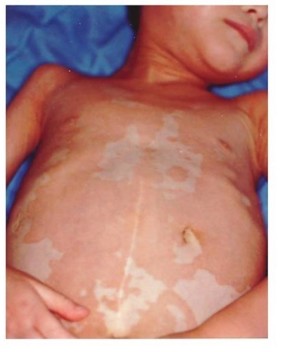(Kamouraska syndrome)
Acronym for Mental retardation, Enteropathy, Deafness, peripheral Neuropathy, Ichtyosis, Keratodermia.
Formerly called: variable type 3 erythrokeratodermia.
Very rare. Initially reported in patients of French origin living in the Kamouraska region in Quebec. Recessive autosomal transmission of a mutation of the AP1S1 gene (7q22.1) coding for a sub-unit of the AP-1 adapter complex, involved in the intracellular transport of the copper-carrying proteins. This syndrome includes some signs and symptoms of Menkes (deficiency in Cu) and Wilson's (toxicity of Cu) diseases, two other abnormalities of the copper metabolism (see these items)..
Characterized by:
- intellectual deficit: cerebral atrophy and sometimes abnormalities of the basal ganglia (on MRI)
- enteropathy: severe diarrhea
- liver damage: hepatomegaly, cholestasis, liver fibrosis and cirrhosis
- sensorineural deafness,
- peripheral neuropathy,
- lamellar and erythrodermic ichthyosis: pale skin dotted with erythematous patches of varying size (cheeks, eyelids, neck, chest, arms)
- keratodermia: hyperkeratosis of the extension surfaces
- facial dysmorphism: high forehead, mongoloid-like palpebral fissures, low set ears
- biology: low plasma ceruloplamin level and high level of free plasma copper, increased plasma levels of very long chain fatty acids

Anesthetic implications:
check liver function; risk of hypovolemia and hypoproteinemia; fragile skin with difficulty securing catheters and tubes
References :
- Martinelli D, Travaglini L, Drouin CA et al.
MEDNIK syndrome: a novel defect of copper metabolism treatable by zinc acetate therapy.
Brain 2013; 136: 872-81.
Updated: October 2024